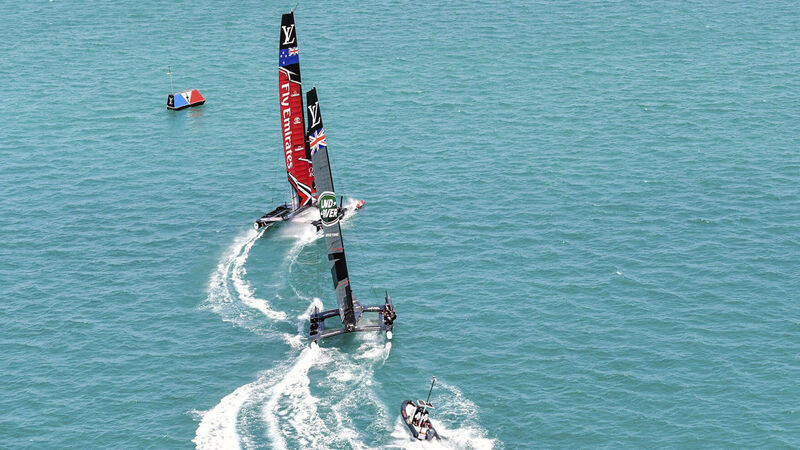Paul Rouse: Billionaires are now battling for supremacy on the ocean waves

Emirates Team New Zealand and Great Britain's Land Rover BAR compete during the 2017 America's Cup. Picture : AP
There is no organised sport in the world where money doesn’t matter. But there is also no sport in the world where money matters quite so much as in sailing.
When a race between two boats can be billed as ‘The Battle of the Billionaires’, you don’t need to be a disciple of Karl Marx to interpret it as being dependent on access to capital.
And so it is that hundreds of millions of euro has been spent by two men who wish to claim the America’s Cup, the most celebrated trophy in the sport of yachting.
In what is basically a semi-final of that competition, the yacht of Jim Ratcliffe, the British founder and chairman of chemicals company INEOS, is currently competing against that of Patrizio Bertelli, the Italian chief executive of Prada, a luxury goods company.
The races in the best-of-13 contest are taking place off the coast of New Zealand — although they have been interrupted by a brief Covid lockdown around Auckland.
The winner of the contest will ultimate proceed to compete for the America’s Cup against the defending champions, Emirates Team New Zealand, in March.
Does any of this matter? Or is it just billionaire boys with their big toys indulging themselves?
The first thing to say is that sailing is not, of course, merely the preserve of the rich. There are people who love the water and sailing boats who stretch their money and their lives to make possible this love. And there is a way into sailing that demands minimal expense and people find it.
But it is nonetheless a simple fact that yachting is a sport that at its apex demands exceptional wealth.
This is a matter of the practical cost of running a yacht — from the purchase of the vessel to the technology required to the cost of staffing (to name just three aspects) — this is not a sport that can be funded by cake sales and flogging lotto tickets for a weekly draw.
It is also a matter of the elitist tradition of yachting as an organised sport. Yachting clubs were among the first sporting clubs established at the dawn of the modern sporting world. And across the world, these clubs were immediately defined as places of status, prestigious and discriminating, the preserve of the elite of society. And between yachting clubs, a hierarchy also emerged that was determined by location and by members’ prestige.
One of the hardest things in sport is to understand why people are involved in a particular sport. In what way are their choices defined (or refined) by the influence of class and gender, commerce and geography, education and employment, and tradition? Or to what extent did the straightforward pursuit of pleasure overwhelm everything else?
It is fair to assume that the men who devote enormous sums of money in pursuit of sailing success love the sport. But it is also fair to ask, what else motivates them?
Because the America’s Cup is about much more than just sailing. From its inception, it has been a platform for rich men to demonstrate the power of their wealth.
The Cup was named after a schooner called ‘America’ which was funded by a syndicate of businessmen to compete against the British yachts in a race around the Isle of Wight that was witnessed by Queen Victoria. The American victory was seen as a harbinger of the arrival of American power.
Thereafter, the America’s Cup saw a succession of exceptionally wealthy people seek the prestige that came from owning a yacht that claimed the trophy. That prestige was wrapped into nationalism. While success in the America’s Cup was monopolised by American boats until the 1980s, challengers were presented as representing a nation coming to claim the trophy from America.
The heyday of this nationalism more recently were the battles between Australians and Americans that dominated the 1980s. These years saw stories of the America’s Cup routinely make the front pages of the newspapers and run as the first story on the television news.
When Australians won the America’s Cup in 1983, it was the first time the Americans had lost in more than 130 years. There were extraordinary scenes.
And then when Dennis Conner won back the America’s Cup in 1987, he was greeted with a ticker-tape parade through New York and a presidential visit.
There are aspects other than nationalism that are wrapped into this. The first is that from almost the beginning, massive legal challenges have been central to the pursuit of victory in the America’s Cup. On one level, these challenges are not dissimilar to the ‘objections’ that for so many decades were part of the GAA; men who lost a match on the field were well-practised in trying to claim it in the committee room.
But the scale of legal engagement in the America’s Cup is reflective of the wealth of those who can afford to retain the most expensive lawyers. Legal challenges began over the contest for the 1871 America’s Cup and have become increasingly more complicated over the decades. During the 1988 contest, the rival American and New Zealand teams spent more time in legal argument than they did racing on the water.
If rich men sought to use the law to win, they also used the racing to promote themselves. The tea merchant Sir Thomas Lipton spent 30 years trying to win the America’s Cup at the beginning of the 20th century. He had been born in Glasgow to parents who had emigrated from Fermanagh in the 1840s. He was the quintessential self-made man and although it is not even clear if he actually liked sailing, he attempted on five occasions to win the America’s Cup.
He did not succeed, but he became hugely famous in the process and this fame did much to help spread his business into America. Indeed, the involvement of Lipton was a signal moment in the evolution of ideas around sports sponsorship and the impact that being associated with a sporting event can have on brand recognition.
Of course, it was a very particular type of brand that sought identification with the America’s Cup. The involvement of Louis Vuitton and Prada in recent decades speaks volumes.
In all of this, technology has played a vital role. When Australia won the America’s Cup in the 1980s, they used a radical new keel design to enhance the speed of the boat. More than that, the intrigue around this design was heightened by the massive ‘modesty skirts’ that enveloped the keel when the boat was out of the water.
More recently, the development of extraordinarily fast multihull boats and then foiling added to the thrill of the racing. And, again, this has been rooted in cutting edge engineering and technologies that cost huge sums of money.
Is any of this any different to wealthy Americans or Russians or Qataris buying soccer clubs? Is the exclusivity of a different order to, say, polo or the most expensive of golf country clubs or ski resorts?
The answer to this is that there is a parallel in that the ultra-rich have a lifestyle that is calibrated differently to the rest of society, even though the world of sport is ubiquitous and interconnected.
But within that lifestyle, the America’s Cup holds the capacity to find a point of distinction. That it is something that very, very few people have ever won means something. And in the terms of its own tradition, it is the sporting prize that is most sought after by the ultra-rich. And tradition, as we all know, matters in sport.
That is not to say that love of yachting does not sit within the ambition of the men who seek to win the America’s Cup — rather that it not enough to adequately explain it.
- Paul Rouse is a professor of history at University College Dublin.

Unlimited access. Half the price.
Try unlimited access from only €1.50 a week
Already a subscriber? Sign in








